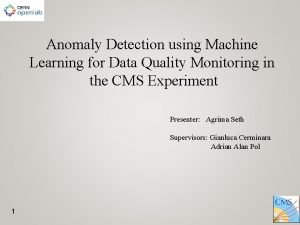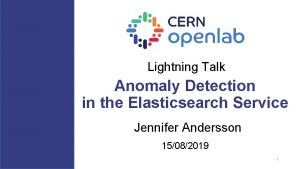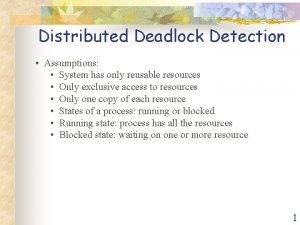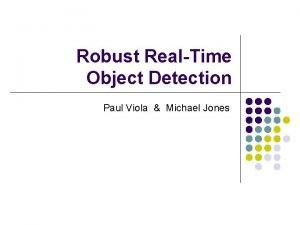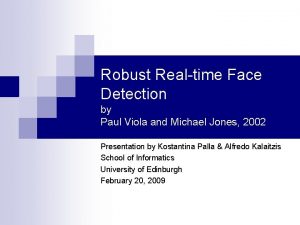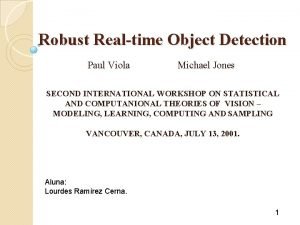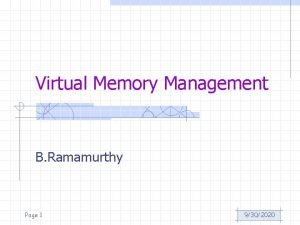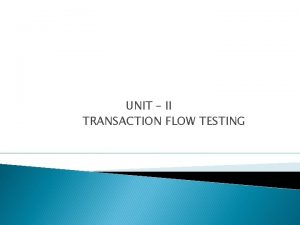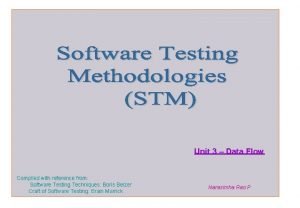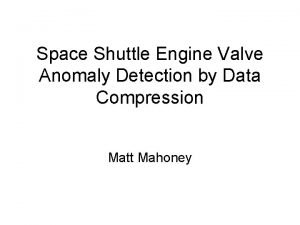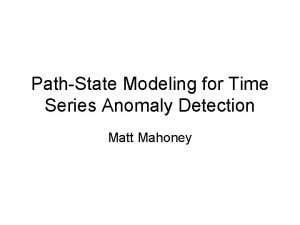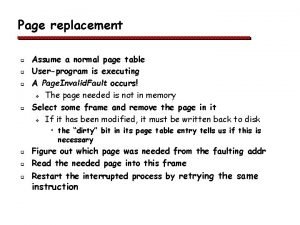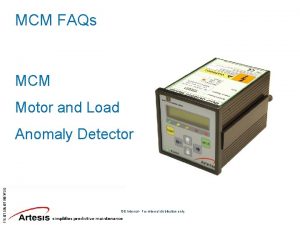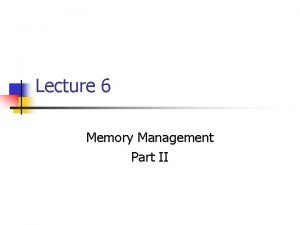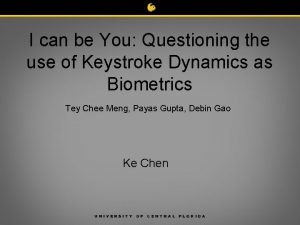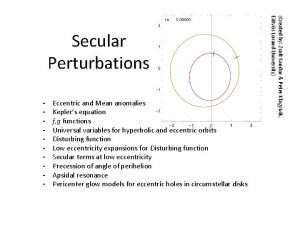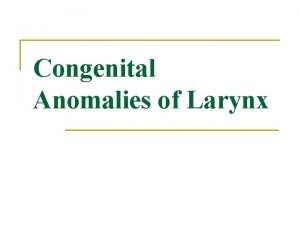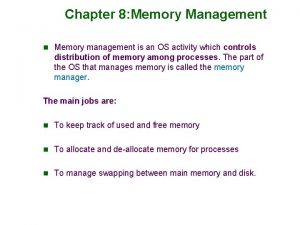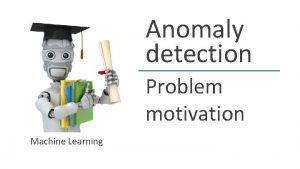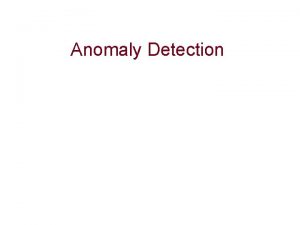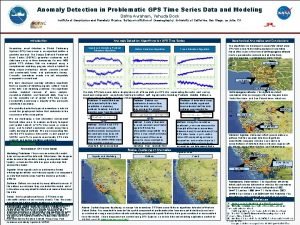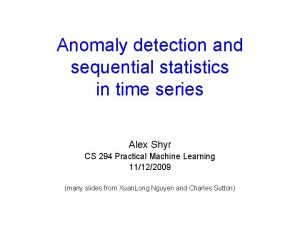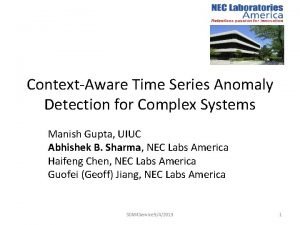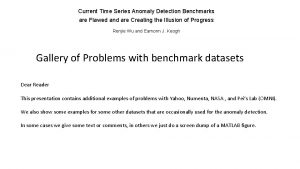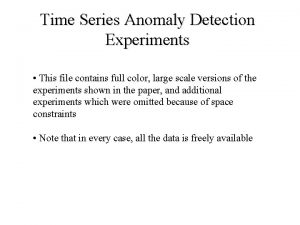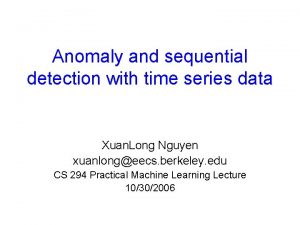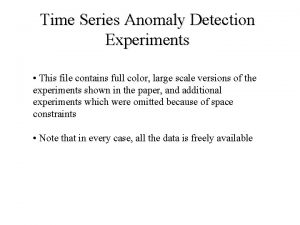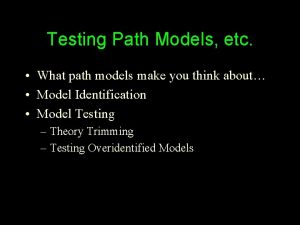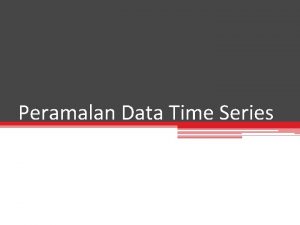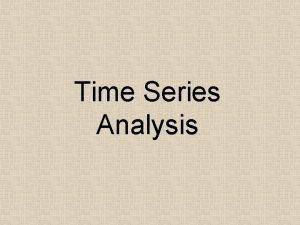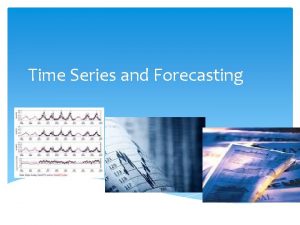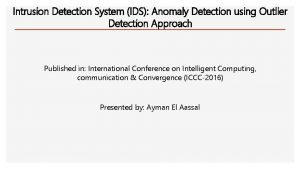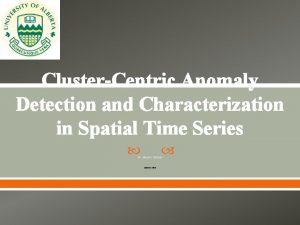Path Models for Time Series Anomaly Detection Matt


























- Slides: 26

Path Models for Time Series Anomaly Detection Matt Mahoney

Problem: How to Detect Anomalies in Time Series Data • Normal Marotta Fuel Valve Solenoid Current (Used on Space Shuttle) • Abnormal (poppet partially blocked)

Manual Rule Specification • Identify features (zero crossings, peaks…) • Specify correct behavior using SCL rules

Automatic Rule Generation (Stan Salvador) • Segment training data (GECKO) • Rule induction (RIPPER) to map data points to segments • Create linear state machine table in SCL

Problem: State Machine May Underconstrain Model Training Segment 1: x = 0, dx = 0 Segment 2: 0 < x < 1, dx = 1 Test Segment 1: x = 0, dx = 0 Segment 2: 0 < x < 1, dx = 3 dx > 0. 5 State 1 State 2 Accept

Derivative Path Model Algorithm • Compute first and second derivative of each training point • Store points in 3 -D (x, d 2 x) space • Scale to unit cube (max – min = 1) • Compute first and second derivative of each test point • Anomaly score = d 2, d = distance to closest training point

Derivative Path Model dx Test Path (d 2 = 4) 3 2 Training Path (scaled to unit cube) 1 1 2 3 x

Derivative Path Example Training Normal Too steep Too low dx d 2 x x Anomaly Score

Filter Path Model Algorithm • As before, but replace derivatives with low pass (LP) filters with time constant T • LP(xt) = (1 – 1/T)LP(xt-1) + xt/T

Filtered Path Model Delayed x 1 Training Path Test Path x 1

Filter Path Example T = 20 T = 100 Training (2000 samples) Test -------> Anomaly Score

Experimental Data • TEK 0 -17 Marotta Valve Solenoid Current – 12 x 1000 x 1 ms – TEK 0 – Training – TEK 1 – Control (normal) – TEK 2 -3, 10 -17 – Various forced failures • Voltage Test 1 – 7 x 2000 x 1 ms (1: 10 undersampled Hall effect sensor current) – 1 training, 2 normal (32 V), 1 hot (70 C), 1 low voltage (30 V), 2 poppet partially blocked (4. 5 and 9 mils) • Battery – 20 x 1000 (simulated), battery 1 voltage – 10 training (various noise added) – 6 abnormal (high or low voltage, some with noise) – 4 normal (some with noise)

Experimental Setup 3 models Derivative Model Diff T=5 T=5 T=10 T=20 T=5 Diff T=5 T=20 Filtered, short delay T=100 Filtered, long delay

TEK Anomaly Scores 0 = training, 1 = normal

TEK Results, Derivative Model TEK 0 TEK 10 (Training) (Normal) TEK 11 TEK 12

TEK Results, Filter, Short Delay TEK 0 TEK 10 (Training) (Normal) TEK 11 TEK 12

Voltage Test 1 Anomaly Scores Nor = normal

Voltage Test 1 Details Hot, 30 V removed

Voltage Test 1, Derivative Model Training (32 V) 9 mil block 30 V

Battery Test Anomaly Scores H = high voltage, L = low, N = normal

Battery Test Details H removed

Battery Test, Derivative Model Training No noise Noise H N H L N No noise Noise

Summary • Path modeling compares test point features to training data – Features may be derivatives or filtered data • Numeric anomaly score (user threshold) • Constrains all data in all directions • Straightforward extension to more dimensions (either features or inputs)

Limitations • No long term state – But filters provide a short term state • No concise (SCL) representation – Point set could have piecewise polynomial approximation • O(n 2) test speed – Must compare each test point with all training points – Could be faster with piecewise model • Does not generalize to unseen data – Considers all dimensions equally important

Future Work • Replace point list with piecewise linear model – Segment path with Gecko or similar – SCL function to compute distance • Extend to multiple dimensions/features – Variable delay filters to add state – May worsen generalization, too many irrelevant dimensions • “Tube” model to improve generalization – Initial training data defines path – Additional training stretches tube (scaling matrix) around path to fit

More information • Open source implementation of path modeling (tsad 1. cpp, tsad 3. cpp) • Technical report of this presentation • http: //cs. fit. edu/~mmahoney/nasa/
 Anomaly detection in google analytics
Anomaly detection in google analytics Anomaly detection spark
Anomaly detection spark Agrima seth
Agrima seth Elasticsearch anomaly detection
Elasticsearch anomaly detection Flink anomaly detection
Flink anomaly detection System log analysis for anomaly detection
System log analysis for anomaly detection Edge chasing algorithm
Edge chasing algorithm Hot path cold path
Hot path cold path Difference between model and semi modal
Difference between model and semi modal Path series addition 71mheatertechcrunch
Path series addition 71mheatertechcrunch Ibm p series server
Ibm p series server Robust real-time object detection
Robust real-time object detection Ada boost
Ada boost Robust real-time object detection
Robust real-time object detection Belady's anomaly example
Belady's anomaly example Transaction flow graph
Transaction flow graph Data flow anomaly state graph
Data flow anomaly state graph Anomaly score
Anomaly score Anomaly score
Anomaly score Wsclock page replacement algorithm
Wsclock page replacement algorithm Mcm anomaly
Mcm anomaly Belady's anomaly example
Belady's anomaly example Anomaly score
Anomaly score True anomaly calculator
True anomaly calculator May hegglin anomaly
May hegglin anomaly Most common congenital anomalies
Most common congenital anomalies Belady's anomaly example
Belady's anomaly example


